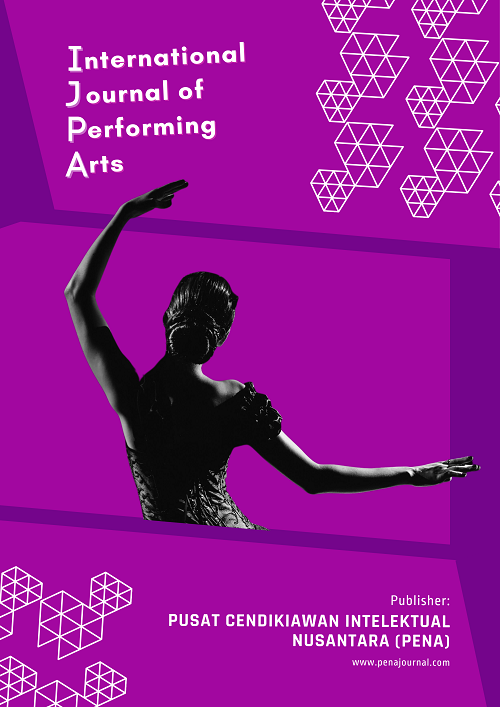AYODYAPALA DANCE STUDIO AS AN AGENT OF CULTURAL EVOLUTION: A NEO-EVOLUTIONARY STUDY OF THE PRESERVATION OF SURAKARTA DANCE IN DEPOK CITY
DOI:
https://doi.org/10.56107/ijpa.v3i2.261Keywords:
Neoevolutionism, Ayodyapala Dance Studio, Surakarta Dance, cultural evolution, art preservation, cultural adaptation.Abstract
This study aims to analyze the role of the Ayodyapala Dance Studio as an agent of cultural evolution
in the preservation of Surakarta Dance in Depok City through the perspective of Marshall D. Sahlins
and Elman R. Service's Neoevolutionism theory. Depok City, as a buffer urban area for Jakarta,
represents a meeting place between tradition and modernity that triggers the process of cultural
adaptation and transformation. Using a descriptive qualitative approach and case study method, this
study examines the dynamics of traditional dance preservation amidst the socio-cultural development
of urban society. The results of the study indicate that the Ayodyapala Studio not only functions as a
forum for dance education and training, but also as an agent of cultural adaptation that maintains
traditional values through innovation in form, function, and performance media. This phenomenon
reflects the concept of specific evolution and evolutionary potential in the Neoevolutionism theory,
where cultural preservation takes place through a continuous process of adaptation without losing
its original identity. Thus, the Ayodyapala Studio plays an important role in maintaining the
continuity of the Surakarta Dance tradition while confirming its relevance amidst the current of
modernization in big cities.
References
Becker, J. (2004). Deep Listeners: Music, Emotion, and Trancing. Bloomington: Indiana University
Press.
Creswell, J. W. (2018). Research Design: Qualitative, Quantitative, and Mixed Methods Approaches
(5th ed.). Thousand Oaks, CA: SAGE Publications.
Firman, T. (2019). Urbanization and dynamics of Jakarta's buffer cities. Journal of Urban and
Regional Planning , 30(3), 233–247.
Haryono, T. (2016). History of Surakarta Style Javanese Dance. Surakarta: ISI Press.
INTERNATIONAL JOURNAL OF PERFORMING ARTS
https://penajournal.com/index.php/IJPA/ 15
Kamila, S., & Sabardilla, R. (2022). Preservation of dance arts at the Jagadhita Kauman Studio in
Surakarta. Gesture Journal , 11(2), 113–124.
Haryono, T. (2016). History of Surakarta Style Javanese Dance. Surakarta: ISI Press.
Heryanto, A. (2018). Identity and Enjoyment: The Politics of Indonesian Screen Culture. Jakarta:
Gramedia Popular Library.
Kaplan, D. (1960). The law of cultural dominance. In MD Sahlins & ER Service (Eds.), Evolution
and Culture (pp. 45–60). University of Michigan Press.
Kleden, I. (2017). Art, Tradition, and Modernity in Indonesia. Jakarta: Obor Indonesia Foundation.
Krippendorff, K. (2018). Content Analysis: An Introduction to Its Methodology (4th ed.). Thousand
Oaks, CA: SAGE Publications.
Kvale, S., & Brinkmann, S. (2009). InterViews: Learning the Craft of Qualitative Research
Interviewing (2nd ed.). Thousand Oaks, CA: SAGE Publications.
Miles, M. B., Huberman, A. M., & Saldaña, J. (2014). Qualitative Data Analysis: A Methods
Sourcebook (3rd ed.). Thousand Oaks, CA: SAGE Publications.
Nasution, F. (2022). The social function of urban dance studios as a forum for cultural preservation.
Jurnal Budaya Nusantara , 5(2), 66–78.
Nugroho, S. (2021). Social and cultural interactions in buffer urban areas. Journal of Reflective
Sociology , 15(2), 287–300.
Patton, M. Q. (2015). Qualitative Research & Evaluation Methods (4th ed.). Thousand Oaks, CA:
SAGE Publications.
Pramudita, F. (2020). The role of art studios in maintaining the existence of traditional dance in the
modern era. Indonesian Dance Journal , 7(1), 34–47.
Putri, E. (2020). Preserving Surakarta-style traditional dance in non-formal education. Journal of
Dance Arts , 9(1), 12–24.
Sahlins, MD, & Service, ER (Eds.). (1960). Evolution and Culture. Ann Arbor: University of
Michigan Press.
Service (Eds.), Evolution and Culture (pp. 45–60). University of Michigan Press.
Service, E.R. (1962). Primitive Social Organization: An Evolutionary Perspective. New York:
Random House.
Soedarsono, RM (2002). Indonesian Performing Arts in the Era of Globalization. Yogyakarta:
Gadjah Mada University Press.
Spradley, J. P. (1980). Participant Observation. New York: Holt, Rinehart and Winston.
Sriyadi, B. (2019). Surakarta-style traditional dance: Its aesthetic and philosophical values. Greget
Dance Journal , 18(2), 45–56.
Stake, R. E. (1995). The Art of Case Study Research. Thousand Oaks, CA: SAGE Publications.
Wallace, A. F. C. (1956). Revitalization movements. American Anthropologist , 58(2), 264–281.
White, L. A. (1959). The Evolution of Culture: The Development of Civilization to the Fall of Rome.
New York: McGraw-Hill.
Yin, R. K. (2018). Case Study Research and Applications: Design and Methods (6th ed.). Thousand
Oaks, CA: SAGE Publications.
Yulindrasari, H., & Rachmawati, Y. (2021). Urbanization and cultural transformation in Indonesian
metropolitan cities. Indonesian Journal of Anthropology , 42(1), 33–48.





















